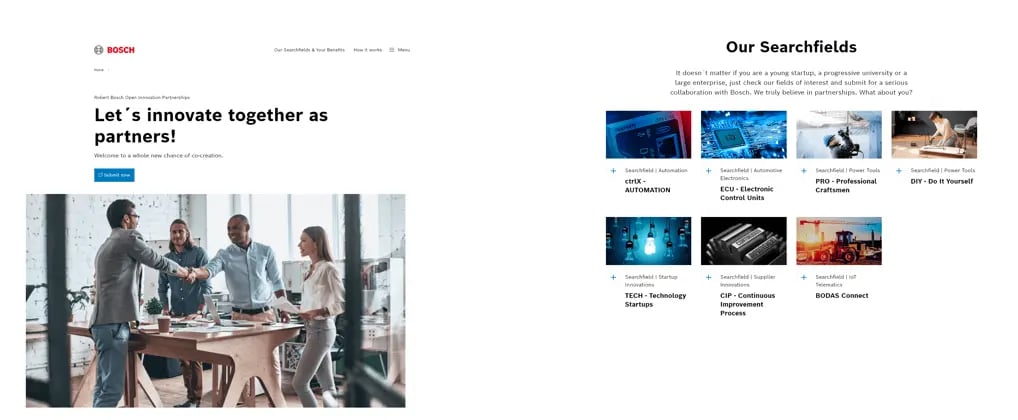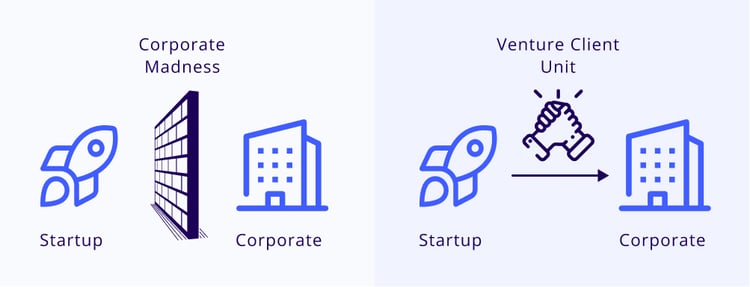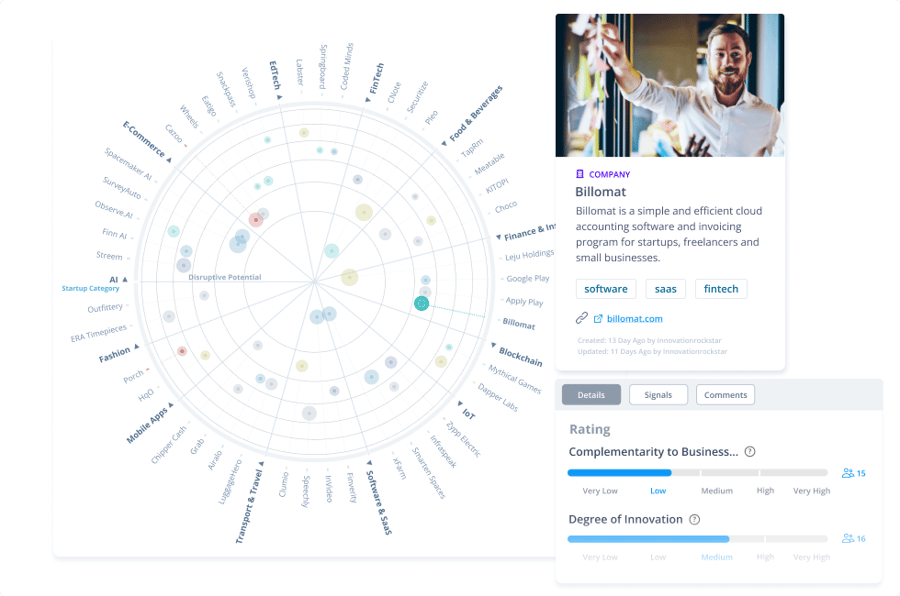Working with large companies as a startup is hard. Vendor selection, vendor registration, compliance, negotiations, the purchasing process, navigating corporate decision-making - everything takes forever. There are oftentimes more people involved in the purchasing process on the corporate side than the startup has employees.
That’s why venture clienting is a new approach that large companies are adopting to ease and speed up partnering with startups and entrepreneurs. In this article, we will discuss what Venture Clienting is, how it is applied, and what challenges companies face when using this collaboration mode.

Exhibit 1: Open Bosch - an example for Venture Clienting
What is venture clienting?
Venture clienting is a relatively new model for pragmatic and successful corporate-startup collaboration. The model involves large companies acting as clients to startups, providing them with early-stage revenues, feedback, expertise development, and access to markets. In return, startups provide innovative solutions and technology that can be integrated into the large company's business operations.
How is this different from corporate venturing?
Venture clienting is focused on identifying corporate opportunity spaces and challenges and matching those with startups that might provide a good solution. Furthermore, Venture Clienting focuses on smooth operations after matching: Instead of complex corporate purchasing procedures, startups can be engaged fast and pragmatically.
In corporate VC, the focus is much more similar to any other venture capital fund: Invest in a certain market niche and make sure to get out with more money than you went in. This oftentimes is - intended or not - decoupled from the corporate opportunities and challenges and therefore ends up being a pure financial play.
From our experience, venture clienting supports a company's innovation strategy better than corporate VC, as it is more pragmatic and faster, and the investment is much lower.
How large companies apply venture clienting
Large companies are applying venture clienting in different ways, depending on their needs and goals. Some companies have created venture client units that act as intermediaries between the company and startups. These units identify and select promising startups, provide them with paid engagements and support, and facilitate their integration into the company's business operations if successful.
A great example is Open Bosch (Exhibit 1). They are part of Robert Bosch Venture Capital, a 100 percent subsidiary of the Bosch group.
Other corporations have adopted an open innovation approach, encouraging startups to submit their ideas and solutions through open calls. This approach enables the company to access a large pool of startups and technologies to evaluate and select the most promising ones to work with. Here again, Bosch is a great example with their Open Innovation Partnerships.
The difference between Open Innovation Partnerships at Bosch and Open Bosch Venture Clienting is the approach: Open Bosch is actively scouting and approaching startups, while Open Innovation Partnerships is recruiting solutions based on defined search fields (such as DIY, IoT, and many more).
Both approaches combined, plus Robert Bosch Venture Capital, allow the Bosch group to cover the Open Innovation spectrum from every angle. It opens up various collaboration opportunities for any organization, university, researcher, inventor, or entrepreneur willing to pitch Bosch their innovative solution.
Benefits of venture clienting for external innovation
There are numerous advantages for leading corporations and early-stage companies to explore corporate-startup partnerships through the venture clienting model that go beyond access to core technology and solutions.
1. Access to resources and expertise
Large corporations have a vast amount of resources and expertise that can help startups to grow and scale their business. Venture clienting partnerships provide startups with access to these resources, including funding, mentorship, industry knowledge, and sometimes simply office space.
The opposite is also true; The pilot projects expose corporates to emerging roles, jobs, and top talent that they currently do not have in-house and will not only help them learn how to remain competitive but also enable rapid growth.
Example: Visa launched a venture clienting program to work with early-stage fintech startups to develop new payment solutions. Through this program, Visa provides startups with access to its network of clients and partners, as well as its expertise in the payments industry.
2. Faster time-to-market
Venture clienting allows startups to test their products or services in a real-world environment with the help of a large corporate partner. This helps startups to get their products to market faster by reducing the time it takes to validate their product, find customers, and capture the most value.
Example: The BMW Startup Garage provides a great example of how they executed rapid prototyping of voice applications provided by a startup.
3. Improved corporate culture
Venture clienting can help large corporations to foster a more entrepreneurial culture by exposing employees to the startup mindset and way of working. This can lead to increased innovation and a more agile approach to problem-solving.
Example: AB InBev, the world's largest brewer, launched its 100+ Accelerator program to work with startups on developing sustainable solutions for the brewing industry. Through this program, AB InBev has exposed its employees to new ways of thinking about sustainability and innovation, helping to foster a more entrepreneurial culture within the company.
Challenges with corporate-startup collaboration
While venture clienting can bring significant benefits to large businesses, it also comes with several challenges, as they oftentimes explore spaces outside of their core business domain. The following are some of the main challenges that companies face when applying this model of growth:
1. Identifying the right startups
Finding startups that have the potential to create value for the company can be challenging. Companies must develop a rigorous and efficient selection process that evaluates the startups' technology, readiness, team, stability, and market potential.
2. Integration into the company's culture
Startups and large companies have different cultures, which can make it challenging for them to work together. Companies need to create a supportive environment and an appropriate level of change management that enables startups to thrive while integrating them into the company's culture.
3. Managing the relationship
Venture clienting involves a long-term relationship between the corporation and the startup, which requires careful management and support. Companies need to establish clear communication channels, routines, and resources, and define expectations to lay the groundwork for success.
4. Managing risks
Investing in startups (even if this is paying them to integrate their solution in the corporate environment) comes with risks, and companies need to manage these risks effectively. This involves developing a robust risk management strategy that includes diversification, due diligence, key performance indicators, and monitoring.
Is venture clienting really worth it?
Venture clienting (Exhibit 2) is a new approach that large companies adopt across various industries to leverage innovation, foster entrepreneurship, and deliver new opportunities through corporate-startup collaborations. The model enables companies to access innovative solutions and technologies from startups while providing startups with early-stage funding, expertise, and market access.
However, venture clienting also comes with several challenges, such as identifying the right startups, managing the relationship, and managing risks. Companies that successfully apply this model can create new business opportunities and stay ahead of current and future competition.
Exhibit 2: Corporate madness vs. venture client unit
How to get started with venture clienting
Getting started with Venture Clienting should be an exciting and rewarding experience. Here are some steps we propose to start your journey in Venture Clienting:
1. Define your goals and objectives
Before you start looking for startups to work with, it's essential to have a clear idea of what you want to achieve through Venture Clienting. Identify the challenges you want to solve, the technologies you want to access, and the business opportunities you want to create.
2. Identify potential areas of innovation
Look at your company's current operations and identify areas where innovation could bring significant benefits. We call these opportunity spaces. This could include improving efficiency, reducing costs, enhancing customer experience, or expanding into new business models and markets.
3. Research the startup ecosystem
To identify potential startup partners, you need to research the startup ecosystem in your industry (and sometimes also beyond). Look for relevant startup events, accelerator programs, and other networking opportunities.
You can also use online platforms such as LinkedIn or Crunchbase to find startups that match your criteria. ITONICS has dedicated mechanisms (and a Crunchbase integration) to speed up this activity.
4. Develop a screening process
Once you have identified potential startup partners, you need to develop a screening process to evaluate them. This should include criteria such as the startup's team, technology, maturity, reference clients, market potential, and fit with your company's culture.
5. Establish a venture client unit
To manage the Venture Clienting process effectively, you may need to establish a venture client unit within your company. This unit should be responsible for identifying potential startups, screening them, and managing the relationship over time. Start small, you and an intern shall do for starters! :-)
6. Develop a clear value proposition
To attract startups, you need to develop a clear value proposition that explains why startups should work with your company. This should include the benefits that startups will receive, such as early-stage revenues, formal and informal feedback, access to expertise, access to markets, and a reference client with a strong logo.
You can also offer to create marketing material like case studies, podcast recordings, or conference presentations in case the partnership is successful.
7. Start small and scale up
When starting with Venture Clienting, it's important to start small and test the waters. This will help you to identify any issues or challenges and refine your approach over time. Once you have established a successful partnership with a startup, you can scale up and work with more startups.
Venture Clienting can be an excellent way for mid-sized and large companies to access innovation fast and stay ahead of the competition.
Following the above steps, you can develop a successful Venture Clienting program that enables you to identify and work with promising startups, access innovative technologies, and create new business opportunities.
With careful planning and execution, Venture Clienting can be a powerful tool for driving growth and innovation in your organization.
How does ITONICS help with venture clienting?
1. Identifying venture clienting opportunities
With our “Where to Play” methodology, the ITONICS software allows for systematic and targeted opportunity identification. Furthermore, many clients use ITONICS Campaigns to collect, evaluate, and aggregate challenges from business units as starting points for venture clienting activities.
2. Startup scouting
Identify the most promising potential partners from the pool of new startups using a simple, systematic approach. Read more on this dedicated use case on startup scouting with ITONICS (Exhibit 3).
Exhibit 3: Scouting startups and evaluating their fit with radar views
3. Matching startups with business opportunities
Through the smart categorization of startups scouted with ITONICS and integrated matching mechanisms, hundreds of startup solutions can be processed and matched easily with business unit challenges and opportunities.
4. Startup relationship management
Like CRM, startup relationship management is about understanding the status and performance of all activities involved in the partnership. ITONICS supports phase-gate partnership management, collaborative evaluations, performance analytics, and reporting.
5. Enabling shared spaces
With ITONICS Sites (Exhibit 4), interactive campaign pages, forms, or full HTML sites can be designed directly within the system. These sites serve as dedicated entry points for collecting specific information and encouraging collaboration to achieve productive ideation.
/Still%20images/System%20Mockups%202025/capabilities-workflows-create-custom-pages.webp?width=2160&height=1350&name=capabilities-workflows-create-custom-pages.webp)
Exhibit 4: ITONICS external sites to enhance collaboration and achieve productive ideation
6. Risk management
Evaluating multiple partnership opportunities from a risk perspective and re-evaluating risk over time is crucial. With ITONICS, risk management is integrated into startup relationship management, where risk portfolios can be managed from various perspectives.
How to turn venture clienting into a scalable innovation strategy
Bringing all these elements together turns Venture Clienting into a structured, end-to-end process. One that connects opportunity discovery, startup scouting, relationship management, and risk control in a single, transparent system. Powered by ITONICS, this approach becomes scalable and measurable across the entire organization, helping teams move faster and collaborate more effectively.
When managed this way, venture clienting accelerates time-to-market, strengthens entrepreneurial culture, and uncovers entirely new opportunity spaces. With ITONICS, you can transform startup collaboration from isolated experiments into a repeatable innovation capability that drives real impact.




